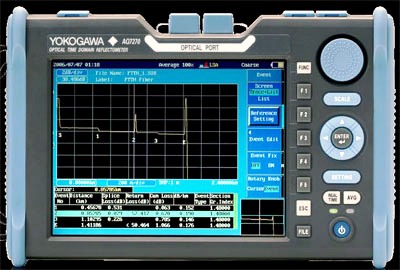
|
|
The Yokogawa AQ7270-735021 1650nm, 30dB Handheld OTDR automatically sets the optimal measurement conditions, performs measurement, performs event analysis, and saves data. Because you can save to a different file name each time you execute, measurement and accumulation of data is easy. In Multi Wavelength Measurement mode, multiple specified wavelengths from the same optical port are measured automatically in order. You can also specify to perform analysis or file saving as needed for each measurement. Specifications. Wavelength: 1650 ±5 nm (At a point -20 dB from the pulse light output peak value). Applicable fiber: SM (ITU-T G.652). Distance range: 500m, 1km, 2km, 5km, 10km, 20km, 50km, 100km, 200km, 300km, 400km. Pulse width: 3ns, 10ns, 20ns, 50ns, 100ns, 200ns, 500ns, 1us, 2us, 5us, 10us, 20us. Dynamic range: 30 dB. Event dead zone: 0.8 m. Attenuation dead zone: 12 m (typ). Sampling resolution: 5 cm, 10 cm, 20 cm, 50 cm, 1 m, 2 m, 4 m, 8 m, 16 m, 32 m. Readout resolution: 1 cm (Min.). Number of sampled data: Up to 50,000 points. Group refractive index 1.30000 to 1.79999 (in 0.00001 steps). Unit of distance: km, kf, or miles. Distance measurement accuracy: Offset error: ±1 m Scale error: Measured distance x2 x10^-5 Sampling error: ±1 sampling resolution. Vertical axis scale: 0.2 dB/div, 0.5 dB/div, 1 dB/div, 2 dB/div, 5 dB/div, 7.5 dB/div. Readout resolution: 0.001 dB (Min.). Loss measurement accuracy: ±0.05 dB/dB. Distance measurement: Displays up to eight digits of the relative one-way distance between two arbitrary points on the trace. Loss measurement: Displays one-way loss in steps of 0.001 dB to a maximum of 5 digits; Displays the one-way loss, loss per unit length, and splice loss between any two given points on the waveform. Return loss measurement: Measures return loss and total return loss of a fiber cable or between two arbitrary points on the trace. Analysis functions: Multi trace analysis, 2 way trace analysis, differential trace analysis, section analysis. Options. /LS: Light source. /PL: Built-in printer, LAN. /DF: Dummy fiber (SMF). /SB: Shoulder belt.
|